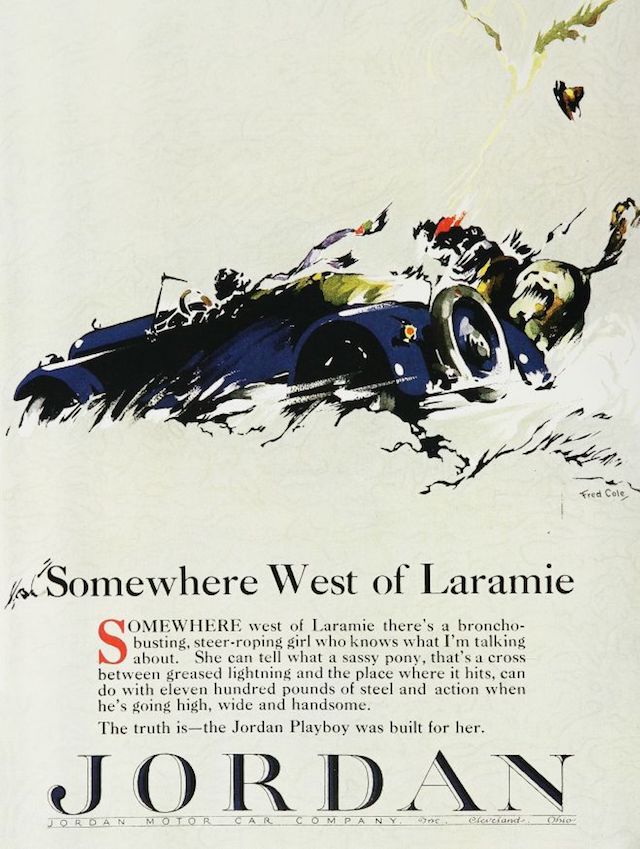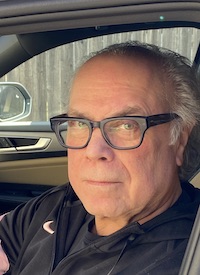MEANINGFUL JOURNEY.
 Monday, March 11, 2019 at 03:53PM
Monday, March 11, 2019 at 03:53PM By Peter M. DeLorenzo
Detroit. In the pantheon of words and phrases that have been grating on me for more than a while, I would like to enter for your consideration the word journey. Now, in a simpler time, the word journey felt a bit wondrous, conjuring images of wide-open spaces, new territories to explore and adventuresome voyages. As it should have.
In 1923, Edward S. Jordan, the founder of the Jordan Motor Company, was desperate to generate business after sales for his Jordan Playboy softened dramatically. With that as background, he created a print ad for his car that changed the automotive advertising landscape forever, and it is still considered to be one of the most influential pieces of ad copy ever written.
The ad – "Somewhere West of Laramie" – was emotionally charged, passionate and filled with compelling imagery, with only a passing mention of the product Jordan was trying to sell. And it has influenced generations of ad makers since. The copy was simply unforgettable, as Jordan captured an emotional resonance never accomplished before in car advertising:
Somewhere West of Laramie there’s a broncho-busting, steer-roping girl who knows what I’m talking about. She can tell what a sassy pony, that’s a cross between greased lightning and the place where it hits, can do with eleven hundred pounds of steel and action when he’s going high, wide and handsome.
The truth is – the Jordan Playboy was built for her.

The ad for the Jordan Playboy, 1923.
Now that is a journey. The lure of the unknown. A place where you’ve never been before but somehow you just know that you’d want to be. A different world. A seductive world. A world removed from day-to-day reality, one marked by freedom and sustenance for the spirit. In 67 riveting words, Edward S. Jordan portrayed the Jordan Playboy as an elixir for the soul.
And that strategy has marked great advertising – automotive and otherwise – ever since. In today’s sanitized and excruciatingly politically correct world, the ability to transform, transport and yes, seduce the consumer still matters and still resonates. And you only have to look as far as Jeep to understand what I’m talking about. Even though the most rigorous terrain encountered by 97 percent of Jeep owners careening around the American landscape might be a city curb they bounce off of at the strip mall, or a pothole they inadvertently drop into, that’s not what Jeep advertising portrays. No, it’s an adventure for the spirit and the idea that only Jeep has the ability to take you to wide-open spaces that you’ve never experienced before.
That imagery has defined Jeep for years, and advertisers have kept the flame alive for decades. It certainly doesn’t hurt that the Jeep products are excellent for the most part, and that in a sea of mundane monthly payments, the Jeep image – which has been burnished in the American conscience since WWII – still shines through.
The Ford Mustang is another car that has thrived on its imagery since its introduction. Again, freedom, wide-open spaces, and the ability to run free is the imagery associated with Mustang. Even non-car people understand what a Mustang is, though they might not necessarily want one. That kind of indelible imagery is worth its weight in gold to a car company.
What about Chevrolet? Having benefited from four of the most iconic advertising campaigns in automotive history – “See the U.S.A. in your Chevrolet”; “Baseball, Hot Dogs, Apple Pie and Chevrolet”; “The Heartbeat of America”; and “Like a Rock” (for Chevy Truck), Chevrolet is now saddled with the shockingly mundane “Find New Roads.” It’s like Chevrolet has given up on inspiring people to experience America in a Chevy and abandoned trying to forge an emotional connection. Instead, they’re just giving you a few suggestions and telling you that you can go do it yourself. Gee, thanks.
VW, of course, captured the imagination of the American consumer public with its quintessential “Think Small” ad, along with many others that projected the simplicity and economy of owning a VW. Even though that was lost in the decades that followed, the imagery associated with VW still has a trace of that iconic 60s advertising breathing in the brand.
And finally, there’s Honda, who stumbled upon the original aura for its brand in this country way back in 1961 with its “You meet the nicest people on a Honda” campaign for its Honda 50 motor scooter. That campaign set the table for the brand in the U.S., and when Honda started to build four-wheeled machines, the lingering good feelings from that campaign gave American consumers permission to check out what Honda had to offer. Some of that imagery still shows up now and again for Honda today.
Now, back to the word journey. As I said earlier, it once had a wondrous connotation, conjuring images of wide-open spaces, riveting adventures and the simple but powerful idea of freedom.
Today, like everything else in this graceless age, the trivialization of the word journey is borderline depressing. Everything is “a journey” these days. Going to school is a journey. Exploring a new coffee flavor at Starbucks is a journey. Trying on new clothes is a journey. Stumbling through a career is a journey. Being sick is a journey. Going to a new hair stylist is a journey. And I’m sure you can fill in countless more examples of this that you come across almost daily.
But I don’t buy any of it for one minute. Actually, none of those aforementioned things qualifies as a journey. Rather, they are in fact another one of my least favorite, mind-numbing phrases: part of a process. Ugh.
If I have to single-handedly launch a movement to bring back the authenticity of words I will. And word No. 1 is journey.
From now on it will be strictly limited to describe the lure of the unknown. A place where you’ve never been before but somehow you just know that you’d want to be. A different world. A seductive world. A world removed from day-to-day reality, one marked by freedom and sustenance for the spirit.
And that’s the High-Octane Truth for this week.






